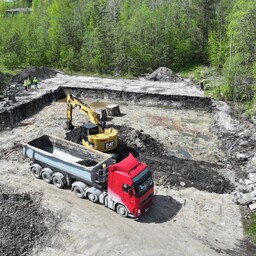Pinnase puhastamine on keeruline, sest reostusmahud on ainult hinnangulised. Tööde käigus selgub, kui palju pinnast tuleb puhastada. Et reostust kergemini kätte saada, lammutati mai alguses vana katlamaja, mille all oli ka reostust. See ala kuulub eraettevõttele Coniery.
Nõukogude ajal olid asfaltbetoonitehased riiklikud. Praegu on see ala
riikliku tähtsusega jääkreostusobjekt
Pärast puhastamist saab seda ala kasutada tootmiseks. Praegu ladustatakse siin täitematerjale. Jääkreostusobjekti puhastamine aitab kaasa ettevõtluse arengule ja töökohtade loomisele.
Väljakaevatud pinnas viiakse Kiviõli
jäätmejaama
Kohtades, kus reostus jääb piiripealseks või ei ületa piirmäärasid, ei ole mõttekas kogu pinnast välja kaevata. Looduslikud protsessid lahjendavad seal reostust aja jooksul ise.
Puhastustööd maksavad 3,4 miljonit eurot. Need lõpevad järgmise aasta suveks. Tööd on jagatud kahte ossa. Praegu toimuv esimene etapp maksab ligi 2,3 miljonit eurot.
Sellel alal on riik varemgi tegutsenud. Aastatel 2009-2013 likvideeriti siin
väikseid reostuskoldeid
The cleanup of an old factory area has begun in Kohtla-Järve. This pollution is very dangerous. The pollution has spread unevenly, but in many places, the concentrations of hazardous substances are too high. For example, the limit for oil products in industrial land is 5000 milligrams per 1 kilogram of dry matter. However, there are places here where this value is 20,000, 30,000, and even 50,000 milligrams. This is dangerous for groundwater, and such pollution cannot be left in the soil.<p>Soil cleanup is complicated because the pollution volumes are only estimated. During the work, it will become clear how much soil needs to be cleaned. To make it easier to access the pollution, an old boiler house, under which there was also pollution, was demolished at the beginning of May. This area belongs to the private company Coniery.<p>During the Soviet era, asphalt concrete plants were state-owned. Now this area is a nationally significant pollution site. The Estonian state wants to get rid of the pollution. The polluters no longer exist, so the polluter-pays principle cannot be applied. Therefore, the state is cleaning up private land.<p>After the cleanup, this area can be used for production. Currently, fill materials are stored here. Cleaning up the pollution site will contribute to business development and job creation.<p>The excavated soil is taken to the Kiviõli waste station. There, the soil is sorted and cleaned. The entire site has about 41,000 cubic meters of polluted soil. Of this, 30,000 cubic meters exceed the industrial land limits.<p>In places where the pollution remains above the limit or does not exceed the limits, it is not practical to excavate all the soil. Natural processes will dilute the pollution there over time.<p>The cleanup work costs 3.4 million euros. It will be completed by next summer. The work is divided into two parts. The first phase currently underway costs nearly 2.3 million euros.<p>The state has acted in this area before. Between 2009 and 2013, small pollution sites were eliminated here. There were small containers containing hazardous substances and bitumen in a semi-underground storage.

